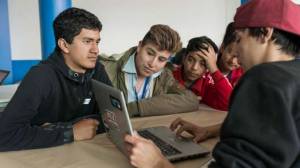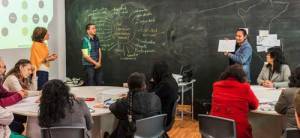Goals
- Use new information and communication technologies (ICTs) to strengthen the safeguarding of ICH, particularly among youth.
- Design and implement school pilots to test a methodology that leverages a number of innovative ICTs, in conjunction with alternative pedagogies, where young people act as protagonists in investigating their own ICH.
With growing access to smartphones and the internet, digital transformation is one of the most important phenomena of contemporary times. Innovative information and communication technologies (ICTs) create new opportunities to connect in impactful ways through immersive experiences. Through pilot projects in 4 schools in Cusco, Peru, this project by CRESPIAL (Regional Centre for the Safeguarding of the Intangible Heritage of Latin America) supported by the GAL (Global Active Learning) School, aimed to look for and implement innovative ICTs for the safeguarding of ICH among school children. To this end, three different ICTs—virtual reality, augmented reality, and digital maps—were variously adopted by eleven groups of school children to explore and share living heritage. Importantly, combining the latter with alternative pedagogies such as active learning allowed the students to be the protagonists in investigating their own ICH.
Broadly, the project aimed to link living heritage, new technologies and education to raise young people’s awareness of the importance of living heritage and to strengthen its transmission in schools. In this, ICTs had a dual purpose: they were both a means of attracting the interest of young people in ICH and were simultaneously useful pedagogical tools, complementary to other strategies such as project-based learning.
Pilot Exercises - Process and Innovative Technologies
The pilot process includes 5 phases in the development of the project: project design, training, research, product creation, disclosure.The different projects began with an initial reflection and design on the part of the teachers, heritage bearers and other stakeholders. This was followed by a training phase of those in charge of carrying out the projects, adjusted depending on their knowledge of ICH and innovative technologies. Next, students set about investigating living heritage, identifying examples of ICH in their own contexts and learning about while documenting them. Based on their research, the participants then created technology products, which leveraged at least one of the innovative technologies mentioned above to describe their ICH. Specifically, they used these technologies to create products showcasing examples of ICH from their environment, revaluing and problematizing them. Virtual reality and augmented reality served as important means of enhancing learning and communication between participants. The use of digital maps made it possible to show pilgrimages and other journeys in a way that was more culturally meaningful as well as interactive and visual. All three allowed for a dissemination process focused on the user’s experience. The projects were then finalized through a sharing of the products and experiences of the students. This Pilot Exercise was conducted as a public event, with the participation of the partners, ICH bearers, community members and the government officials of the two provinces involved.
Pedagogical Approaches and Methodology
The pilot exercises in the 4 schools used alternative pedagogical approaches that proposed an active and participatory methodology on the part of teachers and students. Broadly, a project-based model was developed as a means of stimulating interest and engagement in the subject. This approach was geared towards enabling the student to play a leading role in the development of their research and the project in general. Central aspects of this methodology were learning-by-doing and experiential learning, where experiencing the ICH together with bearers and learning from them directly was considered fundamental. These lived experiences included exchanges with bearers and visits during key moments (workshops, festivities, cooking sessions, etc.).
Stimulating reflection, documentation and analysis of examples of ICH represented a cross-cutting transversal axis of the project. The formal definition of ICH was introduced to the students, who were made to reflect on it during the course of their research while also creating definitions in their own words. Initial examples identified by the students were mainly linked to dances and religious festivals, but over the course of the project, they were able to better conceptualise the importance of the role of community and identity as well as the dynamic nature of the ICH. Some examples of the ICH elements that they incorporated into their notions and subsequently into their projects, were traditional techniques for the production of handicrafts, ritual practices and the knowledge related to nature, among other examples of living heritage of their communities.
A Guide based on the Pilot Experiences
The pilot exercises eventually resulted in the production of a guide that was intended to share the successes and lessons learned so that public, private and civil organisations can replicate such projects in their own environments. In addition to outlining the necessary conditions for an ICH and new ICT project, the guide discusses the various forms such projects can take, depending on the objectives of the group, education levels of participants, their knowledge of ICH and innovative technologies, and available time and resources. Variables to consider in implementing an education project on ICH with innovative technologies include the depth of investigation intended (e.g. simply witnessing, documenting, describing examples of ICH, to actively participating in safeguarding of one or more examples of ICH), the type of innovative technologies to implement, and type of pedagogy (e.g., traditional, active learning, project-based learning).
Furthermore, this guide details the various phases in the development of the project (project design, training, research, product creation, disclosure), including concrete examples of steps to follow according to these five phases, where each phase has clearly delineated objectives, the related actions to take and the materials needed for the project. The guide concludes by offering recommendations for successful projects, a glossary of important terms and an appendix with additional resources on ICH, ICH in the field of education, material with links on innovative technologies and alternative pedagogies, as well as QR codes that can be scanned to view examples of the students’ projects from the pilot exercises.
Project Outputs
- Pilot exercises conducted in four schools (11 groups of students), which integrated ICH in formal education using alternative pedagogies and innovative technologies.
- A Guide on the implementation of ICH, education, and innovative technology projects, based on this pilot experience.
Impact
Employing alternative pedagogies in exploring ICH meant that students themselves developed and directed the research projects, in interaction with their teachers and heritage bearers, increasing the quality and effectiveness of the experience. Combined with the novelty of innovative technologies, the students were able to pursue their research in a more in-depth manner, gaining a greater awareness and understanding of the importance of ICH.
The project assumed that the novelty implied by new technologies would provide an excellent hook to attract the attention and curiosity of young people to their own traditions. Rather, it was observed that exploring and sharing their living heritage was way more important to them. Students were eager to show and discuss what they (and their parents) knew about their ICH and histories, as well as to learn more about that of others. Meanwhile, in implementing pupil-centred, project-based learning, the teachers discovered the students’ prior knowledge, were able to listen to their questions and could guide them in problematizing their reality as well as urging them to come up with their own responses.
Instead of arriving at relatively superficial conclusions such as ‘we practice dance out of tradition’, or ‘we want to share our traditions’, participants were thus well-positioned to try to answer questions such as ‘what other reasons are there for practicing dance?’; ‘why is this tradition important to me’; or ‘what do I hope to achieve through sharing my tradition?’; what are the possible implications of not sharing it?’ Broadly, a more involved approach resulted in greater student engagement and interest in living heritage, as well as creative safeguarding modalities.

© Jorge Castro / Archivo fotográfico del Proyecto Patrimonio Cultural Inmaterial, Educación y Tecnologías Innovadoras de GAL GROUP

© Jorge Castro / Archivo fotográfico del Proyecto Patrimonio Cultural Inmaterial, Educación y Tecnologías innovadoras de GAL GROUP
The content of the projects and documents referenced in this platform do not imply the expression of any opinion whatsoever on the part of UNESCO, including designations employed concerning the legal status of any country, territory, city or area or of its authorities or concerning the delimitation of its frontiers or boundaries.
